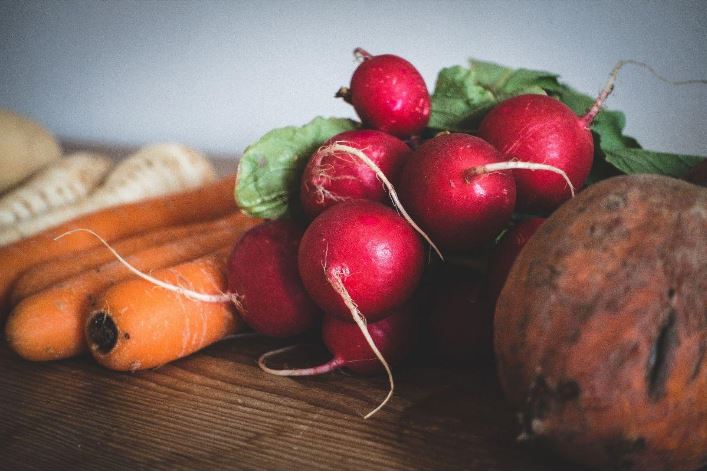One of my favorite types of veggies to grow during our cool season are root crops. There is something so exciting about tending the plants, all the while wondering how they’re growing below ground. For me, it’s like opening a present when you finally get to harvest crops like beets, potatoes, onions, garlic, radishes and turnips.
And if you think a homegrown tomato tastes good, just wait until you pull up a fresh root crop like a carrot. Growing your own root and bulb crops also lets you experiment with varieties not usually found in the store. Add to this the fact that root crops are ultra-nutritious, and you’ve got something to root for!
Once established, underground crops are fairly easy to grow and maintain. Many of these vegetables store well in the ground, which gives you an extended harvest.
Starting now through November is a good time to plant root crops in Orange County, because the ground is still warm. Plant now and the remaining warm weather will get your root crops off to a good start.
You can plant root crops from seed, and sometimes find them growing in the nursery. While it’s best to plant them from seed, I have had luck growing some root crops from transplants, including beets. You must be careful when transplanting them, as their taproots are the root vegetable itself.
I’ve been having a lot of luck growing seed over the last year from True Leaf Market, an independent non-GMO seed company that curates premium seed brands. They carry a bunch of root crop seeds, including beets, carrots, turnips, celeriac, garlic, onion, parsnip, radish, rutabaga, salsify and turnip.
Prepare the Soil
Before planting even one seed, it’s important to consider the secret to healthy root crops—rich, well-draining soil that allows roots to easily penetrate. Unfortunately, many gardeners don’t realize how important soil quality is and what ends up happening is stunted and gnarled root vegetables that lose the battle against the hard clay soil common in many yards.
To have luck growing root crops in the ground, it’s important to generously amend with homemade or bagged compost. Adding gypsum according to package directions is also helpful, as well as incorporating a 1-inch layer of pumice into the growing area.
When you work the soil and mix in amendments, loosen the earth at least 18 inches deep. You should also add a fertilizer high in phosphorus, such as bone meal, which promotes healthy root growth. It is also imperative that the area chosen is well-draining, because root crops will rot if they sit in a sloppy soil.
Choose the Location Carefully
The location you choose for root crops is also important. Make certain that where you’ll be planting gets sun most of the day. An area with very little sun now will probably be shaded in three months. The best place is a southern exposure against a white wall, which will reflect and radiate heat to the plants. A western exposure is also a good choice.
Seeding Root Crops
Root crops are best seeded in place. Trouble comes calling at this time of year, however, if we have a heat wave or Santa Ana winds. It is critical that seedlings never dry out, or you will lose them. That often means misting them once or more times a day until they are an inch or so high. If the day becomes particularly sunny, it’s a good idea to shade the seedlings for part of the day, which will prevent them from getting too hot and drying out.
Patience is critical when it comes to seeding root crops, as some, like carrots, take a while to germinate.
Growing Root Crops in Containers
Many root and bulb crops grow well in containers and raised beds. Both enable you to provide what root crops want most—fast draining soil and a good sunny location at all times.
Pots and raised beds, the latter of which are essentially large containers, do present some challenges to growing root crops, though. Keep the following in mind:
- Use a good potting mix and add a little homemade or bagged compost for extra richness.
- Make sure the container is big enough for what you’re planting. While radishes thrive in small pots, long carrots need containers at least 12 inches deep.
- Try dwarf vegetables when possible. There are a variety of dwarf root vegetables specifically suited for containers such carrots under five inches long, including short ‘n’ sweet, tiny sweet, red-core Chantenay, little finger and the golf ball-size Thumbelina.
- Keep in mind that containers tend to dry out much more quickly than the ground. For that reason, young seedlings especially and container plants in general must be watered on a regular basis. At the same time, you don’t want root crops sitting in water and rotting. Don’t over water and remove container saucers so excess water can flow freely out the bottom of each pot.
- Fertilize container plants about every two weeks with a well-balanced organic fertilizer that contains a high amount of phosphorus.
For detailed information on growing each of these root crops, check out my book Southern California Vegetable Gardening, which comes in paperback and as an e-Book and is free to read on Kindle Unlimited.

